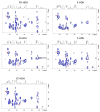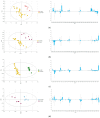Italian Honeydew Honey Characterization by 1H NMR Spectroscopy
- PMID: 40646986
- PMCID: PMC12249152
- DOI: 10.3390/foods14132234
Italian Honeydew Honey Characterization by 1H NMR Spectroscopy
Abstract
Honeydew honey represents a bee-derived product with different organoleptic characteristics and distinct properties with respect to floral honey. The market interest in honeydew honey has been growing in recent years due to its higher bioactive characteristics with respect to floral honey. The need for a deeper chemical characterization aimed to evaluate a possible botanical differentiation attracted the use of different analytical approaches. The present work aims to distinguish the botanical honeydew origin by using Nuclear Magnetic Resonance (NMR) spectroscopy and a multivariate approach. Two different data pretreatments have been considered to obtain the best sample discrimination. The saccharide content significantly affects the differentiation of the botanical variety consisting of fir, oak, citrus fruits, eucalyptus, and forest mainly by using a classification approach taking advantage of the Orthogonal Signal Correction filters. Notwithstanding the botanical diversity of the honeydew honey (HDH) samples, fir honeydew (F-HDH), oak honeydew (O-HDH), and eucalyptus honeydew (E-HDH) resulted always well discriminated among all the botanical varieties investigated, while citrus fruits honeydew (CF-HD) and forest honeydew (FO-HDH) did not. In particular, F-HDH resulted characterized by sucrose, erlose, maltose, maltotriose, maltotetraose, and melezitose, E-HDH resulted enriched in α, β-glucose and β-fructose in furanosidic form, and O-HDH enriched in β-fructose in furanosidic form, isomaltose.
Keywords: NMR spectroscopy; botanical origin; honeydew honey; multivariate statistical analysis.
Conflict of interest statement
The authors declare no conflicts of interest.
Figures





Similar articles
-
Integrated Assessment of Antibacterial Activity, Polyphenol Composition, Molecular Docking, and ADME Properties of Romanian Oak and Fir Honeydew Honeys.Antibiotics (Basel). 2025 Jun 8;14(6):592. doi: 10.3390/antibiotics14060592. Antibiotics (Basel). 2025. PMID: 40558182 Free PMC article.
-
Selected honey as a multifaceted antimicrobial agent: review of compounds, mechanisms, and research challenges.Future Microbiol. 2025 May-Jun;20(7-9):589-610. doi: 10.1080/17460913.2025.2498233. Epub 2025 Apr 28. Future Microbiol. 2025. PMID: 40293032 Review.
-
[Volume and health outcomes: evidence from systematic reviews and from evaluation of Italian hospital data].Epidemiol Prev. 2013 Mar-Jun;37(2-3 Suppl 2):1-100. Epidemiol Prev. 2013. PMID: 23851286 Italian.
-
Chemometric support for the botanical discrimination of honey from Northwest Spain: mineral composition and physicochemical properties.Food Chem. 2025 Jul 3;492(Pt 1):145412. doi: 10.1016/j.foodchem.2025.145412. Online ahead of print. Food Chem. 2025. PMID: 40633513
-
Honey as a topical treatment for wounds.Cochrane Database Syst Rev. 2015 Mar 6;2015(3):CD005083. doi: 10.1002/14651858.CD005083.pub4. Cochrane Database Syst Rev. 2015. PMID: 25742878 Free PMC article.
References
-
- Utzeri V.J., Schiavo G., Ribani A., Tinarell S., Bertolini F., Bovo S., Fontanesi L. Entomological signatures in honey: An environmental DNA metabarcoding approach can disclose information on plant-sucking insects in agricultural and forest landscapes. Sci. Rep. 2018;8:9996. doi: 10.1038/s41598-018-27933-w. - DOI - PMC - PubMed
-
- Kloft W. Problems of practical importance in honeydew research. Bee World. 1963;44:13–29. doi: 10.1080/0005772X.1963.11096973. - DOI
-
- Siddiqui I.R. The sugars of honey. Adv. Carbohydr. Chem. Biochem. 1970;25:285–309. doi: 10.1016/S0065-2318(08)60430-8. - DOI
-
- Beretta G., Granata P., Ferrero M., Orioli M., Facino M. Standardization of antioxidant properties of honey by a combination of spectrophotometric/fluorimetric assays and chemometrics. Anal. Chim. Acta. 2005;523:185–191. doi: 10.1016/j.aca.2004.11.010. - DOI
-
- Lachman J., Orsák M., Hejtmánková A., Kovárová E. Evaluation of antioxidant activity and total phenolics of selected Czech honeys. LWT Food Sci. Technol. 2010;43:52–58. doi: 10.1016/j.lwt.2009.06.008. - DOI
Grants and funding
LinkOut - more resources
Full Text Sources

